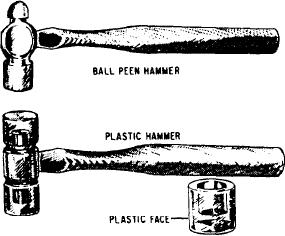
If the tool cannot be located, the person doing
the investigation will sign a lost tool statement and
the VIDS/MAF. The statement indicates that a
lost tool investigation was conducted and that the
tool was not found. After the investigation, follow
the normal VIDS/MAF completion process.
COMMON HAND TOOLS
In this chapter the term common hand tools
is used to refer to small, nonpowered hand tools
that are common to the AD rating. This term
includes such common tools as hammers, socket
sets, wrenches, screwdrivers, and pliers.
Figure 2-1.-Hammers.
Hammers
BALL PEEN HAMMER.-- The ball peen
hammer is sometimes referred to as a machinist's
Hammers are dangerous tools when used
carelessly and without consideration, Practice will
hammer. It is a hard-faced hammer made of
help the inexperienced to learn how to use a
forged tool steel.
hammer properly. Hold the handle near the end
The flat end of the head is called the face. This
with your fingers underneath and your thumb
end is used for most hammering jobs. The other
along the side or on top of the handle. Your
end of the hammer is called the peen. The peen
thumb should rest on the handle and never overlap
end is smaller in diameter than the face and is
your fingers. Oils on the face of the hammer will
useful for striking areas that are too small for the
cause it to glance off the work. Wipe the oil off
face to enter.
with a rag and rub the face with coarse sandpaper
or emery cloth. Never use a hammer that has a
Ball peen hammers are made in different
loose head or cracked handle. Most hammer
weights, usually 4, 6, 8, and 12 ounces and
accidents are caused by a loose head or a slippery
1, 1 1/2, and 2 pounds. For most work, a
handle. So remember these tips when using any
1 l/2-pound or a 12-ounce hammer will do.
kind of striking tool. Tighten the loose hammer-
head by driving a wedge in the end of the handle.
The wedge spreads the handle tightly inside the
MALLET.-- A mallet is a soft-faced hammer.
head. Do not strike a hardened steel surface with
Mallets are made with brass, lead, tightly rolled
a steel hammer. Small pieces of steel may break
strips of rawhide, and plastic heads, Sometimes
and injure someone or damage the work. Use a
the plastic head has a lead core for added weight.
soft hammer in striking hardened steel or highly.
Plastic mallets similar to the one shown in
polished stock. If a soft hammer is not available,
use a piece of copper, brass, lead, or wood to
figure 2-1 are the type normally found in your
protect the hardened steel. It is permissible to
toolbox. The weight of the plastic head may range
strike a punch or chisel directly with the ball-peen
from a few ounces to a few pounds. Use the
plastic mallet for straightening thin sheet ducting
hammer because the steel in the heads of punches
and chisels is slightly softer than that of the
or when installing clamps.
hammerhead.
There are various types of hammers, all of
which are used to apply a striking force where the
Socket Sets
force of the hand alone is insufficient. Each of
The socket set is one of the most versatile tools
these hammers has a head and a handle, even
in the toolbox. Basically, it consists of a handle
though these parts differ greatly from hammer to
hammer. So that you may have a better idea of
and a socket-type wrench that can be attached
to the handle. A complete socket wrench set
their differences and uses, let's consider the types
consists of several types of handles along with bar
of hammers used most frequently. See figure 2-1.
2-3

